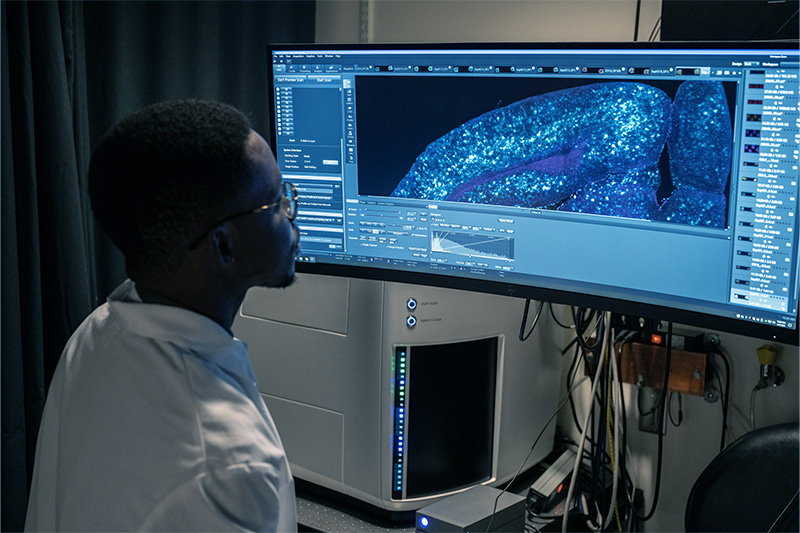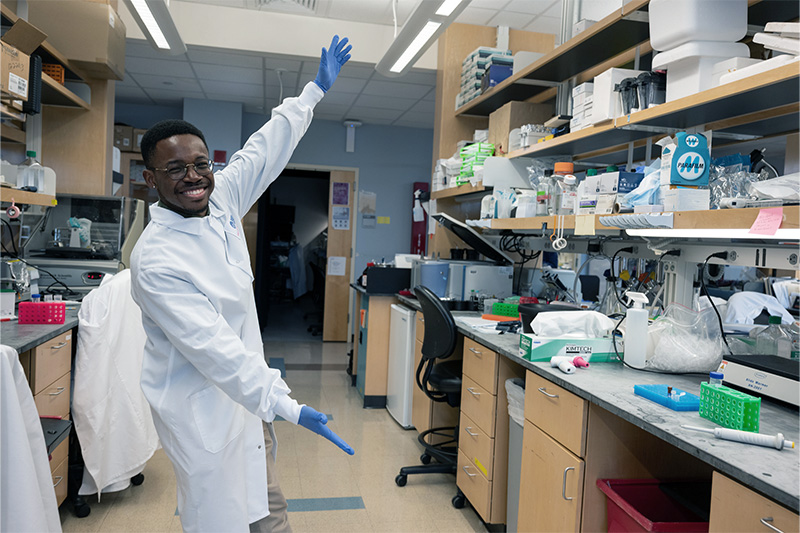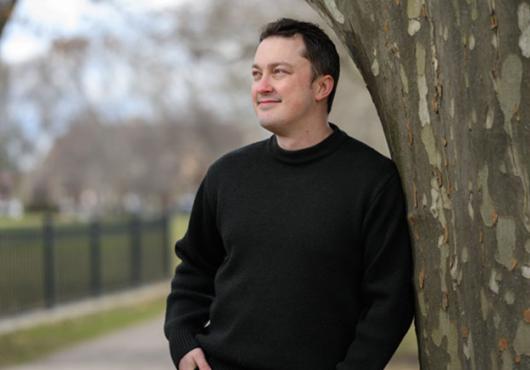
In his short, prolific neuroscience career, Olúmídé Fagboyegun has sought community. It’s served him well, from his years at community college in Maryland to his PhD work at the Harvard Kenneth C. Griffin Graduate School of Arts and Sciences in the lab of Beth Stevens, Harvard Medical School associate professor of neurology at Boston Children’s Hospital.
Fagboyegun found he had to repeat part of high school when he arrived in Maryland from his native Nigeria at age 15. After doing so, he attended Anne Arundel Community College, where the school’s emphasis on mentorship and teaching hooked him.
“They were focused on how to best help students succeed, especially students who were nontraditional,” he said. “These students are often overlooked on the academic path.”
A science scholarship enabled him to finish his final semester without having to work an extra job. He graduated in 2018 as class valedictorian.
Curiosity about astrocytes
Moving on to pursue a bachelor degree in biochemistry at the University of Maryland, Baltimore County, Fagboyegun soon found research-oriented communities, including the Meyerhoff Scholars and U-RISE programs. He earned funding to attend the Annual Biomedical Research Conference for Minoritized Scientists, exposing him to graduate programs and research scientists.
That led to internships at the University of Minnesota and Washington University in St. Louis, where he investigated Parkinson’s and Alzheimer’s diseases. He began thinking deeply about science and the non-lab-bench aspects of being a scientist, such as writing. His interests began to evolve away from biochemistry and into glial cell biology.
Glial cells, which intermingle with neurons in the brain, used to be viewed as mere supporting cells to neurons, Fagboyegun explained. But they’re now known to be players with multiple roles.

Fagboyegun wanted to know more about glial cells, especially astrocytes: star-shaped glial cells whose functions include helping maintain the blood-brain barrier and influencing the formation of synapses between neurons.
Fagboyegun’s curiosity, which he attributes to his parents, has drawn him to labs that push the boundaries of neuroscience.
Taking on big ideas
Fagboyegun became a PhD student at Harvard Griffin GSAS, participating in the Program in Neuroscience (PiN) at HMS. His first rotation brought him to the lab of Maria Lehtinen, HMS professor of pathology and the Hannah C. Kinney, MD, Chair in Pediatric Pathology Research at Boston Children’s.
While Lehtinen doesn’t study glia, she does investigate other non-neuronal cells in the brain. Her specific interest is the cells of the choroid plexus, a little-known tissue in the brain’s fluid-filled cavities that secretes factors regulating brain development, immunity against infection, and more.
“Maria is amazing, a very engaged mentor who’s interested in the nitty-gritty but also in the big ideas,” said Fagboyegun. “We were very aligned.”
Lehtinen agrees. “He’s always eager to test new ideas and think outside the box,” she said. “We would have loved to have him join the lab.”
That honor has gone to the Stevens Lab, which Fagboyegun joined in 2022. With its focus on glial cells and neuroimmune interactions during healthy development and disease, Fagboyegun found a welcoming home there.
“When I have a wild, out-there idea, I go to Beth and she says, ‘Oh, yeah, this sounds really exciting,’” he said.
A new fellowship community
Fagboyegun and Stevens were recently awarded a Gilliam Fellowship by the Howard Hughes Medical Institute as a mentee-mentor pair. Fagboyegun will receive $53,000 in annual support for his dissertation research, with Stevens as his advisor.
“I’ve always had my eye on this fellowship,” Fagboyegun said. “It funds people who are not just doing good science but are also interested in changing the landscape of diversity, equity, and inclusion in the biomedical sciences. The emphasis is on bringing everyone together, often, to interact and brainstorm and help each other navigate challenges.”
His dissertation topic is the cortical microenvironment: the community of substances that surround and interact with cells in the cortex of the brain.

“Every cell in the body is surrounded by a matrix of sugars, proteins, and structural components that shape the way cells and organs function,” he explained. “I’m focused on trying to understand how interactions between cells and the matrix change across brain development and how changes in the matrix influence how cells develop.”
“The only reason I’m able to work on this is because Beth is open to new ideas,” he added.
Stevens is thrilled to have Fagboyegun in the lab.
“Olúmídé has built his research project from the ground up, highlighting features of astrocyte and glial biology that I might not have otherwise pursued,” she said. “He’s a leader and community builder whose enthusiasm for science, excellent communication skills, and kindness will make him a powerful role model.”
Building creativity
Fagboyegun is eager to pay it forward. The F.M. Kirby Neurobiology Center, of which the Stevens Lab is a part, has an initiative that brings students from Bunker Hill Community College to do research in its labs. He’s looking forward to serving as a mentor in the program next summer — a chance to come full circle.
“It requires understanding that people are coming from a lot of different places in life and appreciating the kinds of challenges people face when taking a nontraditional path,” he said.
In his spare time, Fagboyegun enjoys indoor rock climbing and wine tasting, where he’s found other communities. He also enjoys reading, especially fiction.
“When you read, you’re taking the perspective of the characters — it gives you a lens to appreciate the world,” he said. “Fiction is a really effective way to build creativity, which in science is very necessary.”





